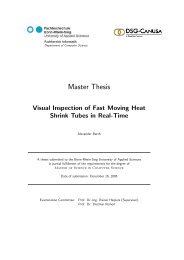Master Thesis - Hochschule Bonn-Rhein-Sieg
Master Thesis - Hochschule Bonn-Rhein-Sieg
Master Thesis - Hochschule Bonn-Rhein-Sieg
You also want an ePaper? Increase the reach of your titles
YUMPU automatically turns print PDFs into web optimized ePapers that Google loves.
6. Evaluating the safety <strong>Master</strong> <strong>Thesis</strong> Björn Ostermann page 105 of 126<br />
- 1600 mm/s if S is equal to or greater than 500 mm<br />
T is the calculated time in Equation 14<br />
C is a constant for the protective equipment, derived from its detection capability:<br />
- C 8� �d�14mm� � , where d is the resolution of the protective equipment<br />
- C � 48mm<br />
at 4 m distance<br />
- C � 72mm<br />
at 5 m distance<br />
The constant C represents the ability of the protective equipment to recognize hands, fingers, etc.<br />
6.2.3 Safety of machinery – Safety-related parts of control systems – Part 1:<br />
General principles for design<br />
EN ISO 13849-1<br />
This standard can be applied to design the safety of the used equipment. Since in this thesis the<br />
developed equipment was left unsafe and the system was secured by other means only the necessary<br />
safety is evaluated at this point.<br />
Figure A.1 of the standard gives an overview at how to choose the performance level the combined<br />
components need to achieve. Applying the graph shown in Figure 73 results in a required performance<br />
level of e, since the possible injuries are serious (S2), the exposure in a collaborative workplace is<br />
continuous (F2) and the possibility of avoiding a 4 m/sec fast robot are scarcely possible (P2).<br />
Figure 73: Risk graph of the EN 13849-1 [72]<br />
The performance level e also requires the control to achieve category 3 to 4, according to figure 5 of<br />
the standard (see Figure 74).














